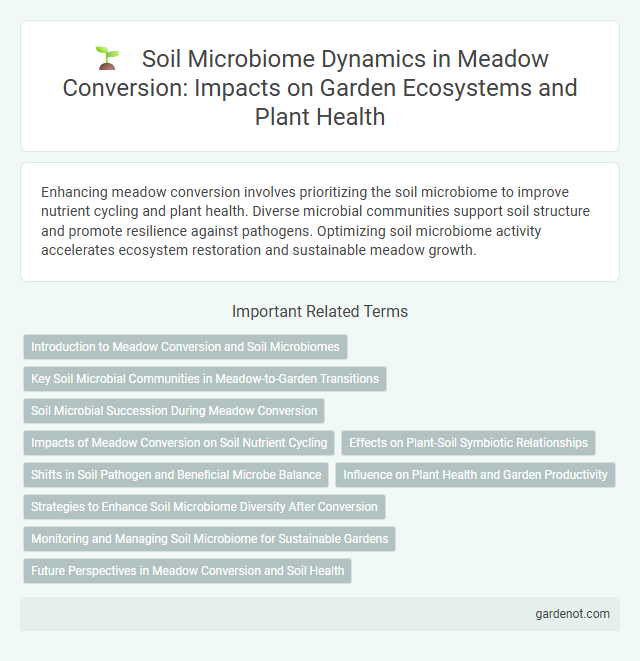Enhancing meadow conversion involves prioritizing the soil microbiome to improve nutrient cycling and plant health. Diverse microbial communities support soil structure and promote resilience against pathogens. Optimizing soil microbiome activity accelerates ecosystem restoration and sustainable meadow growth.
Introduction to Meadow Conversion and Soil Microbiomes
Meadow conversion significantly influences soil microbiomes by enhancing microbial diversity and activity, which improves nutrient cycling and soil structure. Transforming agricultural land into meadow ecosystems increases organic matter input, fostering beneficial microbial communities crucial for healthy soil function. Understanding these soil microbiome dynamics is essential for optimizing meadow restoration and long-term ecosystem sustainability.
Key Soil Microbial Communities in Meadow-to-Garden Transitions
Key soil microbial communities play a crucial role in meadow-to-garden transitions by enhancing nutrient cycling and improving soil structure. Diverse groups, including nitrogen-fixing bacteria such as Rhizobium and mycorrhizal fungi like Glomus, contribute to plant health and resilience during conversion. Monitoring shifts in microbial diversity and function supports successful soil restoration and sustainable garden productivity.
Soil Microbial Succession During Meadow Conversion
Soil microbial succession plays a critical role during meadow conversion by influencing nutrient cycling and soil structure development. Early stages see an increase in copiotrophic bacteria that thrive on fresh organic inputs, while later stages favor oligotrophic microbes adapted to stable carbon sources. Understanding these microbial community shifts is essential for optimizing soil health and promoting sustainable meadow ecosystems.
Impacts of Meadow Conversion on Soil Nutrient Cycling
Meadow conversion significantly influences soil nutrient cycling by altering the composition and activity of the soil microbiome, which plays a critical role in nutrient mineralization and organic matter decomposition. Changes in plant species diversity and root exudates during meadow conversion shift microbial community structure, affecting processes such as nitrogen fixation, nitrification, and phosphorus solubilization. These microbial-driven shifts can lead to variations in soil nutrient availability, impacting overall soil fertility and ecosystem productivity.
Effects on Plant-Soil Symbiotic Relationships
Enhancing meadow conversion significantly alters the soil microbiome, increasing the diversity and abundance of beneficial microbes such as mycorrhizal fungi and nitrogen-fixing bacteria. These shifts improve plant-soil symbiotic relationships by promoting nutrient uptake, disease resistance, and overall plant growth. Studies show that restored meadows exhibit stronger mutualistic interactions compared to monoculture or degraded soils, highlighting the importance of microbiome health in sustainable ecosystem management.
Shifts in Soil Pathogen and Beneficial Microbe Balance
Meadow conversion significantly influences the soil microbiome by shifting the balance between soil pathogens and beneficial microbes. Increased plant diversity in meadows fosters beneficial microbial communities such as mycorrhizal fungi and nitrogen-fixing bacteria, which suppress soil-borne pathogens and improve soil health. These microbiome shifts enhance nutrient cycling, disease resistance, and overall ecosystem resilience in converted meadow soils.
Influence on Plant Health and Garden Productivity
The soil microbiome plays a crucial role in meadow conversion by enhancing plant health through nutrient cycling and disease suppression. Beneficial microbial communities improve root growth and increase resistance to pathogens, thereby boosting garden productivity. Optimizing soil microbial diversity leads to healthier plants and sustainable ecosystem functions in converted meadows.
Strategies to Enhance Soil Microbiome Diversity After Conversion
Enhancing soil microbiome diversity after meadow conversion involves the application of organic amendments such as compost and biochar to improve microbial habitat and nutrient availability. Incorporating diverse plant species through cover cropping and polyculture systems promotes root exudates that boost microbial richness and functionality. Reduced tillage practices preserve soil structure and microbial networks critical for sustaining beneficial microbial communities.
Monitoring and Managing Soil Microbiome for Sustainable Gardens
Monitoring and managing the soil microbiome is essential for sustainable gardens, as diverse microbial communities enhance nutrient cycling and plant health. Techniques such as DNA sequencing and microbial biomass analysis provide detailed insights into soil microbial composition and activity. Implementing organic matter amendments and minimizing chemical inputs help maintain a balanced soil microbiome, promoting long-term garden productivity and ecological resilience.
Future Perspectives in Meadow Conversion and Soil Health
Soil microbiome dynamics play a crucial role in meadow conversion, directly influencing nutrient cycling, soil structure, and plant health. Future perspectives emphasize harnessing microbial diversity to enhance ecosystem resilience and carbon sequestration during meadow restoration. Innovations in metagenomics and bioinformatics will enable targeted manipulation of microbial communities, promoting sustainable soil health and long-term meadow productivity.
Soil microbiome focus Infographic

 gardenot.com
gardenot.com